After the book Ecce Caravaggio. From Roberto Longhi to Today by Vittorio Sgarbi, released last July 8 and to date the first publication onEcce Homo thatemerged last April on the international market at the Ansorena auction house and was attributed to Caravaggio (Michelangelo Merisi; Milan, 1571 - Porto Ercole, 1610), now comes the first scholarly article on the work. It is entitled Caravaggio Millennial. A New Ecce Homo by Merisi, is signed by art historian Maria Cristina Terzaghi, associate professor at the University of Roma Tre, and is the article that opens the volume Caravaggio in Naples and theEcce Homo in Madrid. New Data and New Ideas, published by Ediart. It is the proceedings of the conference Caravaggio in Naples. Research in Progress held at the Capodimonte Museum in Naples on January 13 and 14, 2020, and therefore released with a changed title in order to update readers on the painting that appeared 14 months after the conference. The article consists of thirty-five pages in which Terzaghi confirms his attribution of the painting to Caravaggio.
“The compositional direction of the work, in emperor’s canvas, with half-length figures climbing behind a bare parapet,” Terzaghi states in the article, “is of those of a master of photography. The figure in the background holding the scarlet cloak with his lips half-closed in astonishment is almost swallowed up in the darkness of the half-light from which he advances, while the bloody, yet sweet face of the Man of Sorrows is superimposed on that of the young tormentor with a depth of field of extraordinary emotional effect. The jumbling of planes is felt absolutely dramatically upon a direct viewing of the canvas, which I have been able to see twice so far: before and after its withdrawal from the auction at which it was exhibited. The protagonists seem to be striding toward the viewer. Pilate leans out from the balcony leaning against the pillar, his hands, which have just been washed by the blood of the innocent, open to point to the condemned man abandoned to his fate in a gesture of sublime eloquence, the same that can be read in the face that leans toward the shouting crowd. We sense that crowd in the governor’s bewildered gaze. The two Romans have a feral quality about them compared to the figure of the helpless Jesus crowned with thorns, of a perfect and intact humanity, despite the blood dripping in rivulets from his forehead, ’like a lamb led to the slaughter, like dumb sheep before its shearers,’ goes the prophecy of Isaiah.”
 |
| Caravaggio (attr.), Ecce Homo (oil on canvas, 111 x 86 cm) |
In the article Terzaghi traces the origin ofCaravaggio’s compositional idea to theEcce Homo painted by Paris Bordon (Treviso, 1500 - Venice, 1571) around 1559-1560 for the Cardinal of Lorraine and now owned of the antiquarian Maison d’Art in Monte Carlo (principality of Monaco), of which several variants exist and which therefore, according to the scholar, Caravaggio could have been familiar with given his familiarity with Venetian figurative culture. In favor of an attribution to Caravaggio would play, meanwhile, some morphological details: the model impersonating Pilate and appearing to be the same one we see in the guise of St. Peter Martyr in Caravaggio’s Madonna of the Rosary preserved at the Kunsthistorisches Museum in Vienna; the crown of thorns similar to that of the Flagellation owned by the Ministry of the Interior and exhibited at the National Museum of Capodimonte; the purple of the mantle that has the “same pictorial value” as that of the Salome with the head of the Baptist now in the Palacio Real in Madrid (“a canvas,” Terzaghi writes, "whose palette agrees singularly with that of theEcce Homo, as far as can be perceived under the layer of oxidized varnish that dulls the painting“). Also among the revealing details is the one described as ”not too common“ of the ”clear, almost luminous brushstroke" of the mark in the center of the crown of thorns, a detail that could be (as Sara Magister points out in Ecce Caravaggio. From Roberto Longhi to Today by Sgarbi) the cut branch of the crown of thorns.
No less important is the topic of ancient copies. Mention is made of the copy (although not of such high quality) first published by Roberto Longhi in a well-known essay of his in 1954 (and brought to attention in relation to theEcce Homo Ansorena by Federico Giannini in the columns of Finestre sull’Arte during an interview with Rossella Vodret) and which for Terzaghi should be considered an antique copy of the Madrid painting. Then there is a painting passed at auction by Il Ponte in Milan on October 22, 2013, a larger version of the Madrid canvas from which it departs by the addition of some iconographic details and a more rigid rendering of robes and faces. Still, a copy exists in a private English collection, purchased on the Kent antiques market several decades ago. “The print run of the copies,” Terzaghi writes, seems “a further clue to confirm the attribution of the Madrid painting to Caravaggio, whose inventions, as is well known, were disseminated with great generosity.”
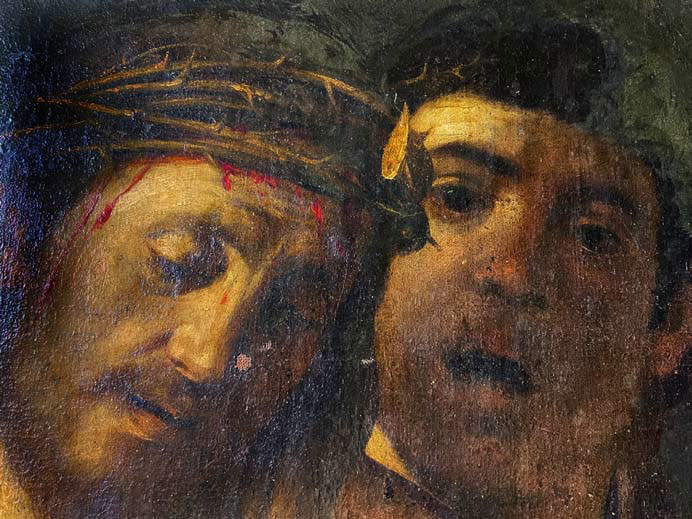 |
| Caravaggio (attr.), Ecce Homo, detail of the faces of Jesus and the henchman |
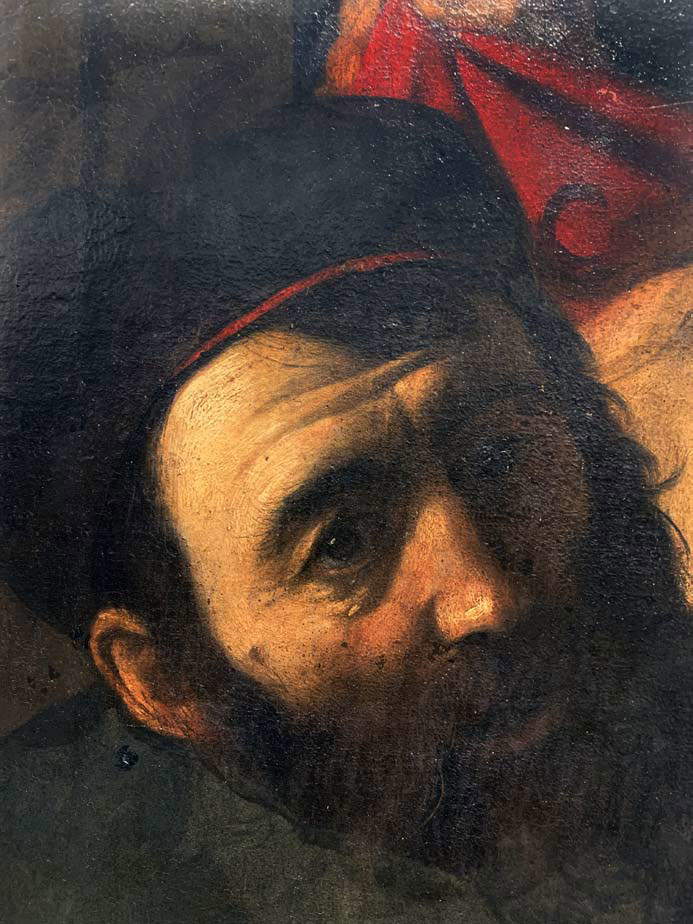 |
| Caravaggio (attr.), Ecce Homo, detail of the face of Pilate |
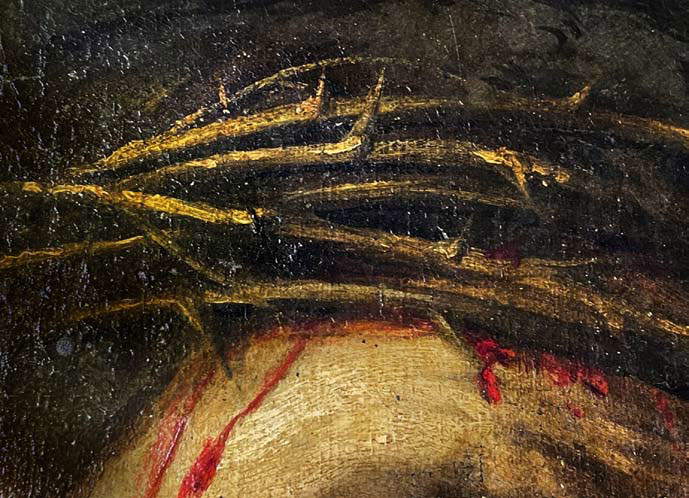 |
| Caravaggio (attr.), Ecce Homo, detail of the crown of thorns |
The Lombard scholar then takes up the positions of the critics: in favor of the attribution from the earliest hours Vittorio Sgarbi, Massimo Pulini, Tomaso Montanari, Keith Christiansen, Francesca Curti (who had not commented on the painting, but only on the documents), Sybille Ebert-Schifferer, Stefania Macioce, Catherine Puglisi, David M. Stone, Rossella Vodret, and Alessandro Zuccari; more skeptical Keith Sciberras, Gianni Papi, Riccardo Lattuada, and Antonio Vannugli (Vodret and Vannugli expressed themselves from the columns of Finestre sull’Arte). The history of provenance, also reconstructed on these pages with several articles, is then traced. TheEcce Homo is owned by the brothers Diego, Mercedes and Antonio Pérez de Castro Méndez, who received the canvas through inheritance: further back in time, the work was owned by Spanish politician and council president Evaristo Pérez de Castro (Valladolid, 1769 - Madrid, 1849). Indeed, the inventories of his collection included an Ecce Homo given to Caravaggio and with an estimated value of sixteen thousand reals (second only to an Ecce Homo by Annibale Carracci in the same collection): Pérez de Castro received the work after proposing to the Academy of San Fernando in Madrid an exchange of a Saint John the Baptist by Alonso Cano owned by him for one work among four to be selected from the Academy’s catalog published in 1821, leaving the choice to the institution. The four works were a rare Christ gathering robes by Cano himself, a Penitent Magdalene by Esteban Murillo, a Lot and Daughters by Benedetto Luti, and an “Ecce-Hommo con dos saiones del Carabaggio.” “Before deciding which painting the collection could do without,” Terzaghi reconstructs, "the academicians inquired about the provenance of the paintings, not wanting to exchange a painting whose ownership could be claimed by another institution, a case that was not impossible, given the comings and goings of works that entered and left the collection between 1818 and 1823. The choice fell onEcce Homo by exclusion, since Magdalene was in the Academy’s ancient inventory, Alonso Cano’s painting was among those seized by France and then returned, Lot and his daughters ’ provenance was unknown, and finally: ’El Ecce-Homo non se de donde vino pues en el inventario de pinturas recogidas en casa de Manuel Godoy no consta un quadro del tamaño come el que tiene el de Caravaggio, por lo que me parece (sin prejudicio que l’Academia disponga) se le podria cambiar’."
TheEcce Homo that was the subject of the exchange no longer appears in the Academy’s later printed lists, which instead record Alonso Cano’s Saint John the Baptist . However, it is not known exactly where theEcce Homo was before it arrived at the Academy. In 1816 the painting was almost certainly in the Buenavista Palace, once the property of the Duchess of Alba, and then in 1802 passed to the Madrid City Council and then purchased by Prince Manuel Godoy in 1807. According to Terzaghi, however, theEcce Homo does not seem to be identifiable with the works that belonged to the nobleman’s collection, partly because Godoy, once he purchased the palace, was also able to take possession of some works already in the building. During the Napoleonic era, the palace moreover had received works arriving from suppressed convents in preparation for the creation of the Josefino Museum, the museum designed by Joseph Bonaparte and his commissioner of Fine Arts, Frédéric Quillet. Before arriving at the Buenavista Palace, however, the work was probably at the Real Casa de Campo, a place where Bonaparte often stayed. The move, however, according to Terzaghi, would not be related to Napoleonic events, but rather to those of the collections of the Spanish royals, since the Real Casa de Campo also housed several works donated by King Charles IV to Manuel Godoy: according to what the scholar hypothesizes, the work should have come to the Real Casa from the Palacio del Buen Retiro (another site from which Manuel Godoy drew for his collections, having received the king’s approval), where in 1789 an Ecce Homo attributed to the ambit of Caravaggio is recorded (“Vara y medio de alta y cinco cuartas escasa de ancho. Un Ecceomo con dos figuras más, en dos mil reales. Estilo de Carabajio”), which on the basis of measurements could correspond to a similar work appearing in 1701-1702 in the private apartments of King Charles II (though without attribution). No further earlier passages are known, although, Terzaghi notes, the inventory of Philip IV ’s possessions kept in the Alcázar in 1666 mentions an “Otra pintura, de bara y quarta de alto y bara de largo, con moldura de ébano, Cristo quando le muestran el pueblo, de medias figuras, de mano de Jerardo, ed ducientos y cinquenta ducados de plata.”
 |
| Paris Bordon, Ecce Homo (1559-1560; oil on canvas; Monte Carlo, Maison d’Art) |
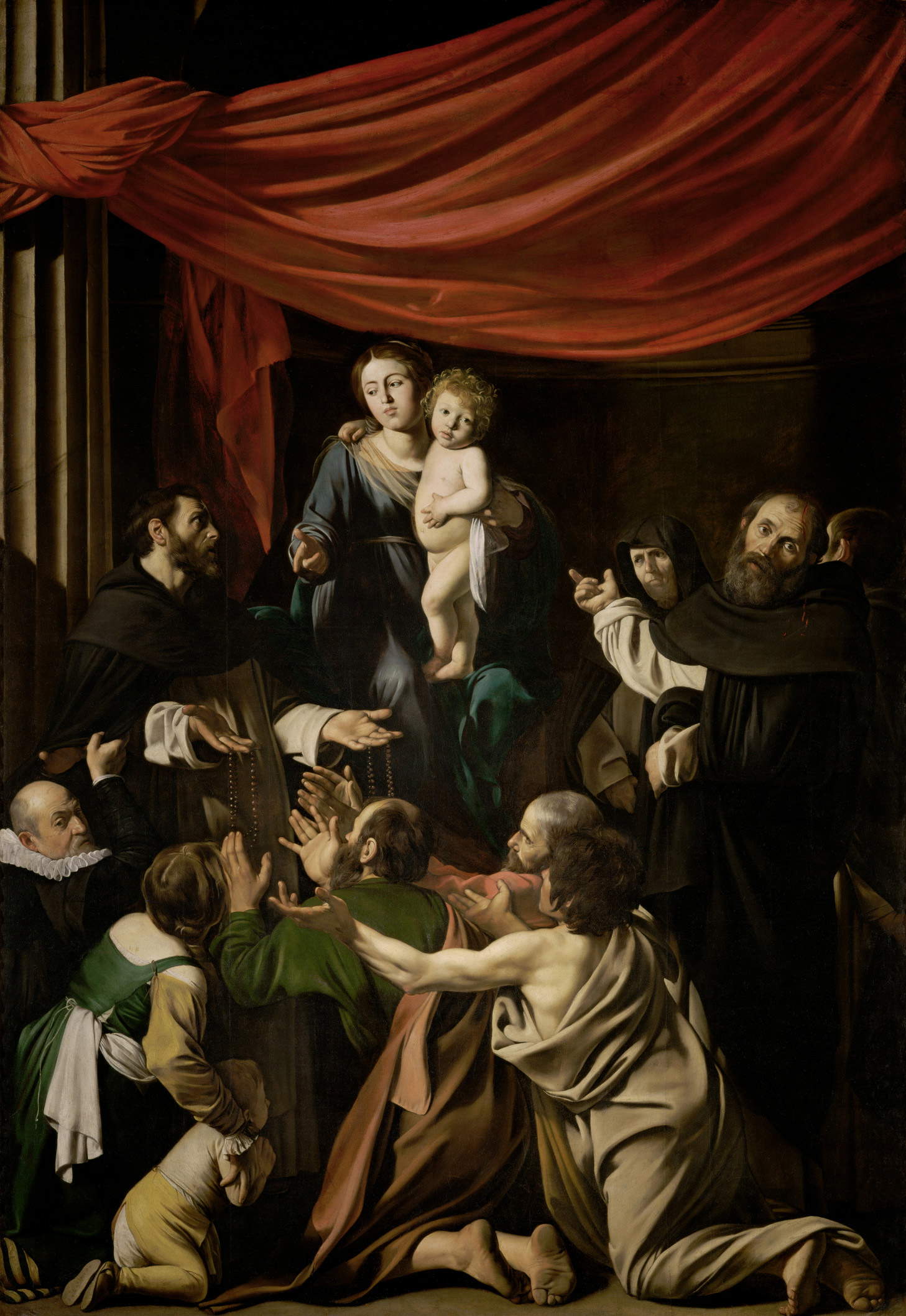 |
| Caravaggio, Madonna of the Rosary (c. 1605-1607; oil on canvas, 364.5 x 249.5 cm; Vienna, Kunsthistorisches Museum) |
 |
| Copy from Caravaggio, Ecce Homo (oil on canvas, 107 x 84 cm; location unknown) © Fototeca Fondazione Roberto Longhi, inv. 096323 |
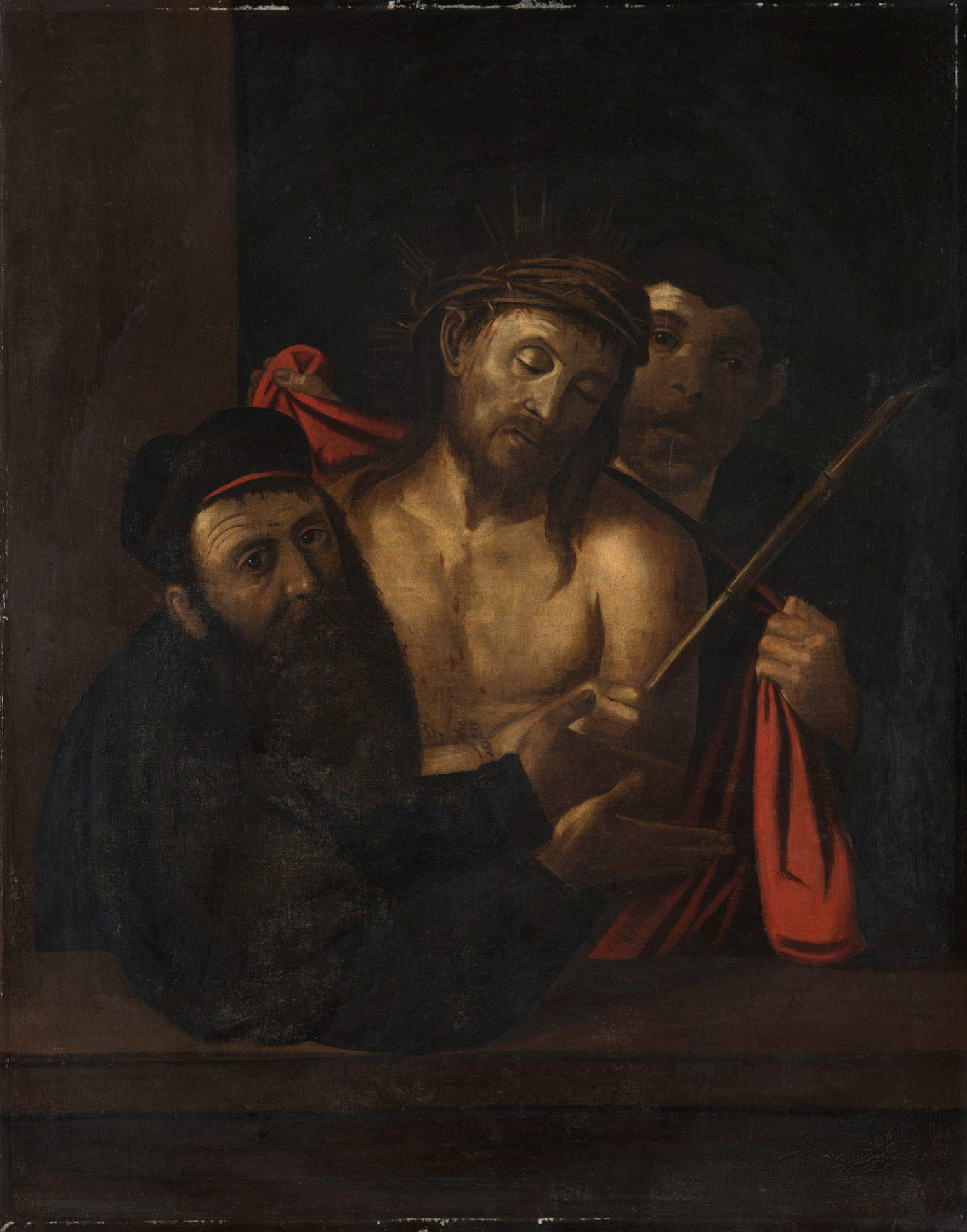 |
| Copy from Caravaggio, Ecce Homo (oil on canvas, 130 x 100 cm; formerly Il Ponte Casa d’Aste, auction 313, October 22, 2013, lot 32) |
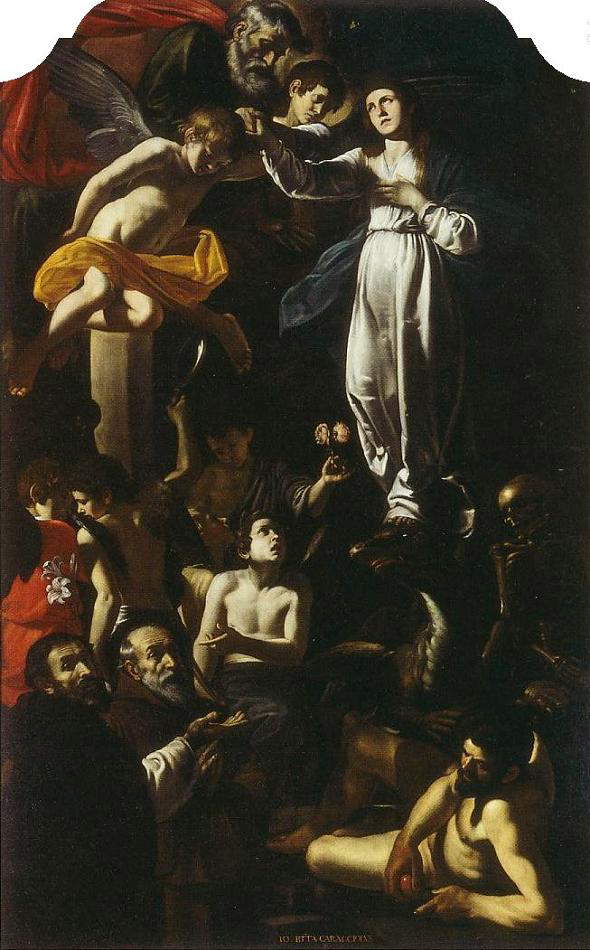 |
| Battistello Caracciolo, Immaculate Conception with Saint Dominic and Saint Francis of Paola (1607-1608; oil on canvas, 334 x 209 cm; Naples, Santa Maria della Stella) |
It has been speculated that theEcce Homo arrived in Spain through the viceroy of Naples, García de Avellaneda y Haro, second Count of Castrillo (Écija, 1588 - Madrid, 1670), who returned to his homeland in 1659 after holding office in Naples for six years. An art collector, his inventories record two paintings attributed to Caravaggio, a Salome with the Head of the Baptist (the one now in Palacio Real) and an Ecce Homo. The idea of identifying this work with the one in the 1666 inventory, according to Terzaghi “does not seem so peregrine.” According to the scholar, the dimensions while not coinciding do not seem incompatible, and the estimate (two hundred and fifty silver ducats) is very high. However, it is not known where the Count of Castrillo had purchased the canvases. "Attempting to go back as far as possible to the first owner of theEcce Homo,“ Terzaghi writes, ”the hypothesis that Castrillo had purchased it on the Neapolitan market and in particular that the painting was the same one recorded in 1631 in theinventory of Juan de Lezcano, secretary to Francisco Ruiz de Castro from April 29, 1609 Spanish ambassador to Rome, then, viceroy of Palermo (1616-1622), is very tempting. In Lezcano’s inventory an Ecce Homo attributed to Merisi appears to be the most valuable piece, as suggested by the high valuation of 800 ducats, which no other painting reached. Moreover, the description fits like a glove with the canvas now in Madrid: ’Un eccehomo con Pilato que lo muestra al pueblo y un sayon que le viste de detras la veste porpurea’. The qualification of: ’Quadro grande original del Caravagio y esta pintura es estimada en mas de 800 ducados,’ with which the inventorial mention continues, should not be alarming. Making comparisons with works whose identification is more certain (particularly the many canvases by Orazio Borgianni, of whom Lezcano was a true admirer), we can deduce that the inventory divided the paintings into ’muy grandi’, when they had the measurements of an altarpiece, meant by ’large’ works that were around 125-126 cm in height (or width), and smaller works were classified as ’median’ or ’pequeñe’. The rather small size of the MadrilenianEcce Homo (cm 111 in height) is therefore not incompatible with the Lezcano canvas, especially if one considers that one must add the width of the frame, which is itself also recorded in the inventory along with the painting. It cannot therefore be ruled out that the Count of Castrillo purchased the work from the person who had acquired Juan de Lezcano’s collection, which was destined to be alienated upon his death by the express will of the secretary himself, who wished that the proceeds could cover debts incurred during his lifetime."
The last two aspects the article focuses on are theEcce Homo ’s possible relationship with the Massimi commission (the article summarizes the affair without, however, coming to any conclusions about possible relationships) and its context in the context of early seventeenth-century Neapolitan painting. It is precisely from stylistic analysis, according to Terzaghi, that the “most significant data on the origin of the canvas” seem to come.
According to the scholar, “the connection with the artist’s Neapolitan works and also with those of his followers seems quite evident,” despite the work’s state of preservation and despite the “difficulty that still persists in serializing the southern production of the master.” Terzaghi comparesEcce Homo with Battistello Caracciolo ’s Madonna della Stella (a work preserved in Santa Maria della Stella in Naples). “In this, which is perhaps one of the highest outcomes of Caravaggio’s reception not only in Naples, but in Europe,” the scholar writes, “the beautiful Saint Dominic in the foreground entertains very close relations with Caravaggio’s Pilate, especially for the eloquence of the gesture, to which the lesson of the Vienna Rosary certainly underlies, but which finds in the Ecce Homo a further compositional cue. The very high date of Battistello’s masterpiece, certainly executed between October 1607, the date of payments to the painter, and the same month of the following year, when the wooden frames were being welded to the gilders, seems to constitute an ideal ante quem for the Madrid painting as well. But by 1608 Caravaggio was in Malta. I think it is therefore correct to date the Madrid painting before the artist’s departure for the island.” According to Terzaghi, it is “certain [...] as of now the greatness of this masterpiece that evidently left a trace in the heart and in the brush of those who were able to see and appreciate it”: among the works on whichEcce Homo left a trace is also mentioned a painting by Domenico Fetti, a term of comparison, this one, established for the first time by Massimo Pulini. Now, however, “only restoration,” Terzaghi concludes, “will make it possible to adequately read the subject matter of the Spanish painting.”
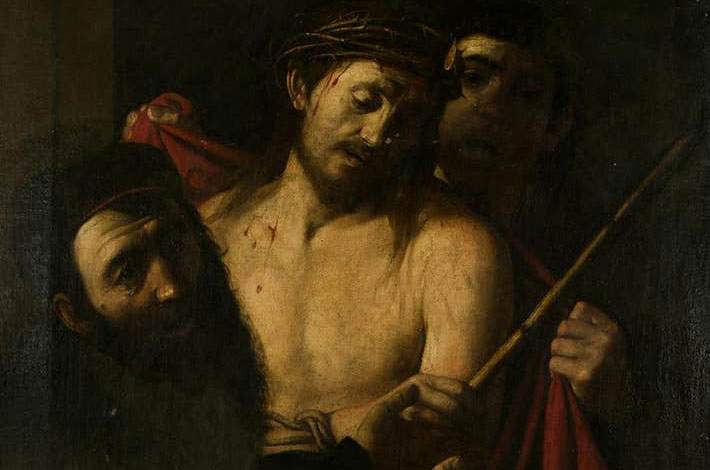 |
| Maria Cristina Terzaghi publishes first scientific paper on Ecce Homo: "it's by Caravaggio" |
Warning: the translation into English of the original Italian article was created using automatic tools. We undertake to review all articles, but we do not guarantee the total absence of inaccuracies in the translation due to the program. You can find the original by clicking on the ITA button. If you find any mistake,please contact us.